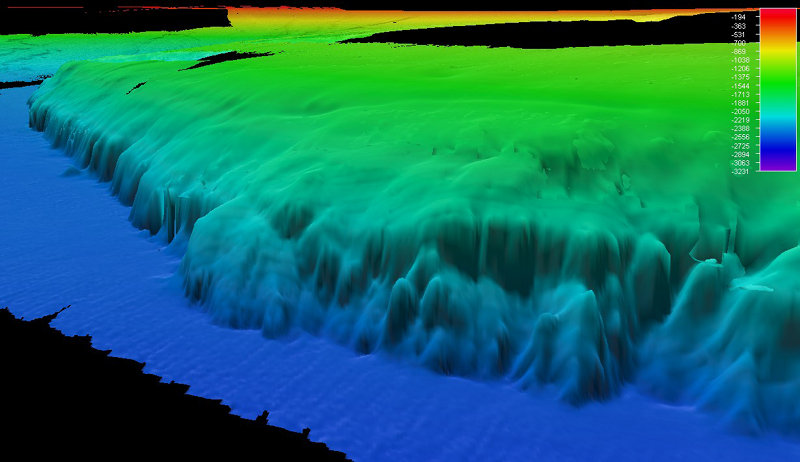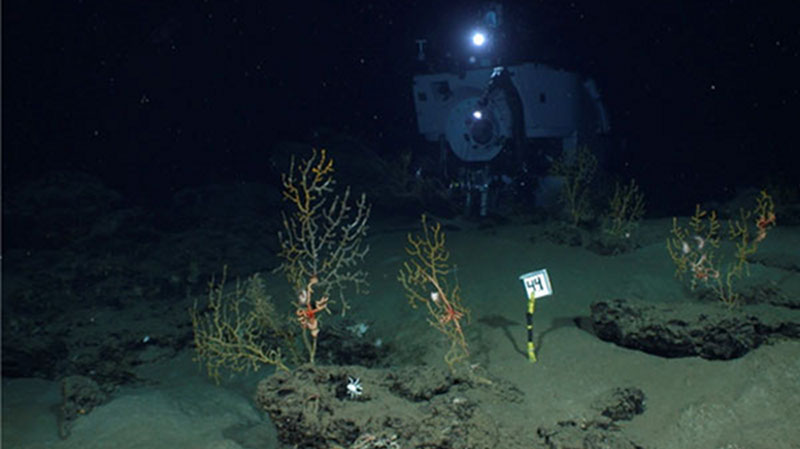
By Tim Shank, Leg II Science Team Lead - Woods Hole Oceanographic Institution

Bathymetry of the West Florida Escarpment. The base of the escarpment (2,600 meters depth) is shown in blue with the upper rim more than 600 meters above. We will have at least four dives sites that cover the diverse soft sedimented and hard carbonate rock bottom between 2,300 and 400 meters to explore the physical structure of the seafloor and biodiversity on soft and hard bottom habitats (Multibeam data from EX1105, EX1106, and this expedition, EX1202). Image courtesy of the NOAA Office of Ocean Exploration and Research. Download larger version (jpg, 419 KB).
The deep Gulf of Mexico is dominated by soft sediments and mud. Amidst this expansive terrain, there are veritable islands of carbonate rock, steep scarps, brine lakes covering the seafloor, and patchworks of sulfide and methane seepage, providing diverse habitats for animals. These areas typically host two types of animal communities: chemosynthetic fauna associated with seepage and coral and sponge communities on hard bottom.

Bamboo corals (with an attached crinoid) on a scarp wall in the DeSoto Canyon area (2,055 meters depth). Image courtesy of the NOAA Office of Ocean Exploration and Research. Download larger version (jpg, 1.7 MB).
Along the upper slope of the Gulf of Mexico, in water depths shallower than 1,000 meters, studies over the past 20 years have provided a wealth of information on the communities that thrive in patchy seep communities and more recently, the first assessments of structure, distribution, and diversity of coral communities. Even this basic information suggests that the communities at these deep sites differ significantly from the upper slope communities in terms of their composition and biogeography (patterns of species ranges). However, the ecology and even the basic distribution of seeps and coral ecosystems remain poorly understood.

Corals and associated animals living with them in the vicinity of the Deepwater Horizon oil spill (within 11 kilometers) as captured by a time-lapse camera image. The submersible Alvin is in the background. Image courtesy of Chuck Fisher and T. Shank, Woods Hole Oceanographic Institution. Download image (jpg, 50 KB).
In May 2011, NOAA’s Office of Exploration and Research hosted a workshop comprised of members of the science community, educators, and federal and state partners to discuss ways to increase our knowledge of unknown and poorly known ocean areas. These areas are now targets of our current EX1202 Leg II mission: the northern West Florida Escarpment, the DeSoto Canyon in the NE Gulf, the vicinity (within a tens of kilometers) of with the Deepwater Horizon or Macondo Well, and deepwater shipwrecks.
The West Florida Escarpment represents a novel continental margin consisting of shallow-water carbonates rather than deep-water sediments. The escarpment reflects the dramatic subsidence experienced by the Gulf of Mexico when it was tectonically active. The escarpment is marked by canyons which appear to be erosional. The 2,000-meter deep canyons have semi-enclosed to open basins which may funnel sediment into the canyon heads. The habitats within these structures are virtually unknown but may contain seeps, hardbottom assemblages and isolated softbottom islands.
The DeSoto Canyon area has not been well explored. It is well known that whales utilize the canyon area for feeding. Seep and coral communities have been reported in the region, based on two previous remotely operated vehicle dives in the region. The types of species observed were often either considered new (e.g., a new species of mussel was found at a seep site) or considered more closely related to those in the Atlantic than in the Gulf of Mexico (e.g., corals and the animals living on them).
The exploratory mission of EX1202 Leg II is to investigate the biogeographic differences, that is, the suggested theory that species living in the deep DeSoto Canyon area are distinct from other species in the Gulf of Mexico. Identifying these patterns can provide critical information for establishing hypotheses as to why this may be; perhaps the physical circulation of the Gulf, including the loop current act to direct larval dispersal and exchange with populations in the Atlantic, but not with the western Gulf. We will explore the soft bottom and hard bottom scarps of the region thought to host hydrocarbon seeps and hard bottom coral and sponge communities.

Mosaic of the Ewing Bank Wreck at 621 meters in the Gulf of Mexico. This three-dimensional perspective of the Ewing Bank Wreck was produced by "draping" the photo mosaic over the multibeam bathymetry. The photos and multibeam data were collected with the C-Surveyor autonomous underwater vehicle. Image courtesy of C & C Technologies, Inc. Download larger version (jpg, 129 KB).
The Deepwater Horizon Oil spill in the northeastern Gulf discharged more than 4.9 million barrels (or 206 million gallons) of oil over 87 days at a depth of approximately 1,500 meters as well as 1.1 million gallons of chemical dispersants sprayed at the wellhead. To learn more about deep-sea communities in regions of active drilling, we will explore the deep-sea coral, sponge, and sediment communities in the vicinity (a few to tens of miles away) of the Deepwater Horizon.
Shipwrecks also provide islands of hard bottom habitats for sponge and coral communities. Shipwrecks represent the cultural heritage, historical, and archeological significance to the world public. They also provide key scientific information, perhaps most importantly, once identified, they can provide a rare time frame for the age of the life and ecosystems living on them. During the course of this cruise, we will explore for three shipwrecks and if found, will not only represent a significant archeological find, but the fauna they host will be surveyed and compared to other hard bottom communities in the region and throughout the Gulf.
The expectation of multiple discoveries, from discovering unknown ecosystems, potentially new species, new biogeographic regions, and shipwrecks, makes this cruise of exploration an intensely exciting endeavor.